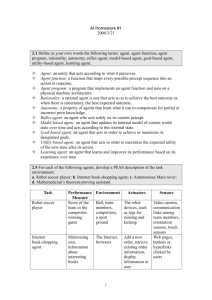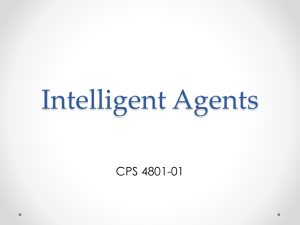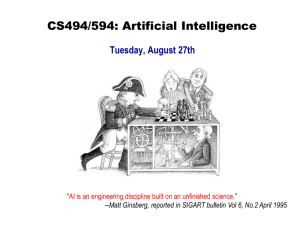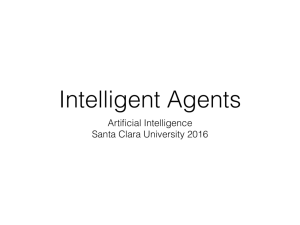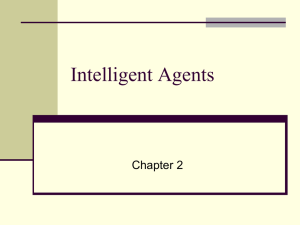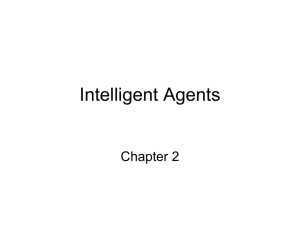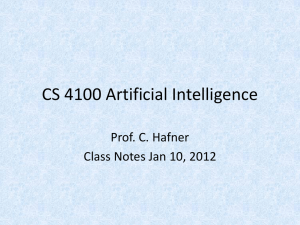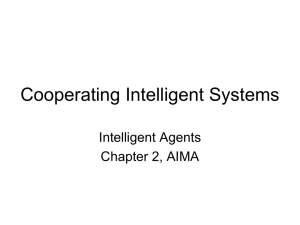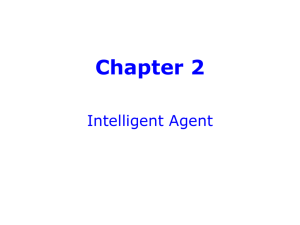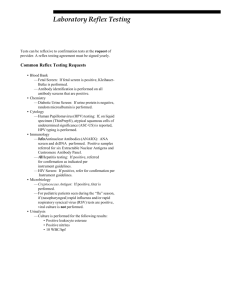Introduction
advertisement
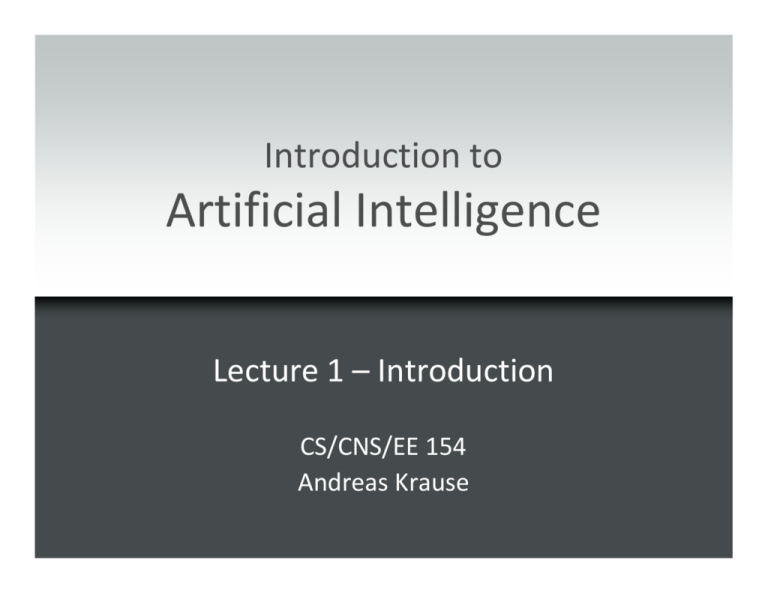
Introduction to
Artificial Intelligence
Lecture 1 – Introduction
CS/CNS/EE 154
Andreas Krause
2
What is AI?
“The science and engineering of
making intelligent machines”
(McCarthy, ’56)
What does “intelligence” mean??
3
The Turing test
Turing (’50): Computing Machinery and Intelligence
Predicted that by 2000, machine has 30% of fooling a
lay person for 5 minutes
Currently, human-level AI not within reach
4
What if we had intelligent machines?
Will machines surpass human intelligence?
Should intelligent machines have rights?
What will we do with superintelligent machines?
What will they do with us?
…
5
AI today
6
Autonomous driving
Caltech’s Alice
DARPA Grand Challenges:
2005: drive 150 mile in the Mojave desert
2007: drive 60 mile in traffic in urban environment
7
Humanoid robotics
Honda ASIMO
TOSY TOPIO
8
Autonomous robotic exploration
??
Limited time for measurements
Limited capacity for rock samples
Need optimized
information gathering!
9
A robot scientist
[King et al, Nature ’04, Science ‘09]
10
Games
IBM’s Deep Blue wins 6 game match against
Garry Kasparov (’97)
11
Games
Go: 2008: MoGo beats Pro (8P) in 9-stone game
Poker: Next big frontier for AI in games
12
Computer games
13
NLP / Dialog management
[Bohus et al.]
14
Reading the web
[Carlson et al., AAAI 2010]
Never-Ending Language Learner
After 67 days, built ontology of 242,453 facts
Estimated precision of 73%
15
Scene understanding
[Li et al., CVPR 2009]
16
Topics covered
Agents and environments
Search
Logic
Games
Uncertainty
Planning
Learning
Advanced topics
Applications
17
Overview
Instructor:
Andreas Krause (krausea@caltech.edu) and
Teaching assistants:
Pete Trautman (trautman@cds.caltech.edu)
Xiaodi Hou (xiaodi.hou@gmail.com)
Noah Jakimo (njakimo@caltech.edu)
Administrative assistant:
Lisa Knox (lisa987@cs.caltech.edu)
18
Course material
Textbook:
S. Russell, P. Norvig: Artificial Intelligence,
A Modern Approach (3rd edition)
Additional reading on course
webpage:http://www.cs.caltech.edu/courses/cs154/
19
Background & Prequisites
Formal requirements:
Basic knowledge in probability and statistics (Ma 2b or
equivalent)
Algorithms (CS 1 or equivalent)
Helpful: basic knowledge in complexity (e.g., CS 38)
20
Coursework
Grading based on
3 homework assignments (50%)
Challenge project (30%)
Final exam (20%)
3 late days, for homeworks only
Discussing assignments allowed, but everybody must
turn in their own solutions
Exam will be take home open textbook. No other
material or collaboration allowed for exam.
Start early! ☺
21
Challenge project
“Get your hands dirty” with the course material
More details soon
Groups of 2-3 students
Can opt to do independent project
(with instructors permission)
22
23
Agents and environments
Agents: Alice, Poker player, Robo receptionist, …
Agent maps sequence of percepts to action
Implemented as algorithm running on physical architecture
Environment maps sequence of actions to percept
24
Example: Vacuum cleaning robot
Percepts P = {[A,Clean], [A,Dirty], [B,Clean], [B,Dirty]}
Actions A = {Left, Right, Suck, NoOp}
Agent function:
Example:
25
Modeling the environment
Set of states S (not necessarily finite)
State transitions depend on current state and actions
(can be stochastic or nondeterministic)
26
Rationality: Performance evaluation
Fixed performance measure
evaluates environment seq.
For example:
One point for each clean square after 10 rounds?
Time it takes until all squares clean?
One point per clean square per round, minus one point per move
Goal: find agent function (program) to maximize
performance
27
PEAS: Specifying tasks
To design a rational agent, we need to specify
Performance measure, Environment, Actuators, Sensors.
Example: Chess player
Performance measure: 2 points/win, 1 points/draw, 0
for loss
Environment:
Chess board, pieces,
rules, move history
Actuators:
move pieces, resign
Sensors:
observe board position
28
PEAS: Specifying tasks
Example: Autonomous taxi
Performance measure: safety, fare, fines, satisfaction, …
Actuators:
road network, traffic rules, other
cars, lights, pedestrians, …
steer, gas, brake, pick up, …
Sensors:
cameras, LIDAR, weight sensor, ..
Environment:
29
Environment types
Sudoku
Poker
Spam Filter
Taxi
Observable?
Deterministic?
Episodic?
Static?
Discrete?
Single-agent?
30
Agent types
In principle, could specify action for any possible
percept sequence
Intractable
Different types of agents
Simplex reflex agent
Reflex agents with state
Goal based agents
Utility based agents
31
Simple reflex agent
Action only function of last percept
32
Example
Percept
Action
[A,dirty]
Suck
[B,dirty]
Suck
[A,clean]
Right
[B,clean]
Left
Will never stop (noop), since we can’t remember state
This is a fundamental problem of simple reflex agents in
partially observable environments!
33
Reflex agent with state
Action function of percept and internal state
34
Example
State vars: cleanA = cleanB = false
Percept
cleanA
cleanB
Action
[X,dirty]
?
?
Suck
[A,clean]
?
true
NoOp
[A,clean]
?
false
Right
[B,clean]
true
?
NoOp
[B,clean]
false
?
Left
State change
cleanX = true
? means “don’t care”
35
Goal-based agents
36
Utility-based agents
37
What you need to know
Agents interact with the environment using sensors
and actuators
Performance measure evaluates environment state
sequence
A perfectly rational agent maximizes (expected)
performance
PEAS descriptions define task environments
Environments categorized along different dimensions
Observable? Deterministic? …
Basic agent architectures
Simple reflex, reflex with state, goal-based, utility-based, …
38
